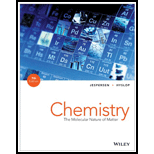
Concept explainers
Interpretation:
The formula of the complex ion formed by silver
Concept Information:
Complex ions are the ions which are formed by the metal atom at the center and the other nonmetal molecules or ions surrounds it.
Lewis acid-base reaction is the reaction between the lewis acid (loss of pair of electrons) and lewis base (gain of pair of electrons).
Ligands are the molecules or ions that bond with a coordinate covalent bond to form a metal ion.
To write the formula for a complex, following rules are utilized:
The symbol for the metal ion is always given first, followed by the ligands.
When more than one kind of ligand is present, anionic ligands are written first (in alphabetical order), followed by neutral ligands (also in alphabetical order).
The charge on the complex is the algebraic sum of the charge on the metal ion and the charges on the ligands.
The formula is placed inside of the square brackets with the charge of the complex ion as a superscript outside the brackets. When the charge is zero the brackets and charge are omitted.
Answer to Problem 1PE
Solution:
The formula of the complex ion that is formed by silver
Explanation of Solution
The most common oxidation state of silver
The complex ion
According to the rule of nomenclature for the coordination complex, the given complex ions are formulated as
Want to see more full solutions like this?
Chapter 21 Solutions
Chemistry: The Molecular Nature of Matter
- What types of isomers are possible for the following compounds or complex ions? (a) K[Co(NH3)2Cl4] (b) Pt(en)Cl2 (square-planar) (c) [Co(NH3)5Cl]2+ (d) [Ru(phen)3]Cl3 (e) Na2[MnCl4] (tetrahedral) (f) [Co(NH3)5NO2)2+arrow_forwardAn aqueous solution of [Rh(C2O4)3]3− is yellow. Predict the approximate wavelength and predominant color of light absorbed by the complex.arrow_forward
 Chemistry: Principles and ReactionsChemistryISBN:9781305079373Author:William L. Masterton, Cecile N. HurleyPublisher:Cengage Learning
Chemistry: Principles and ReactionsChemistryISBN:9781305079373Author:William L. Masterton, Cecile N. HurleyPublisher:Cengage Learning General Chemistry - Standalone book (MindTap Cour...ChemistryISBN:9781305580343Author:Steven D. Gammon, Ebbing, Darrell Ebbing, Steven D., Darrell; Gammon, Darrell Ebbing; Steven D. Gammon, Darrell D.; Gammon, Ebbing; Steven D. Gammon; DarrellPublisher:Cengage Learning
General Chemistry - Standalone book (MindTap Cour...ChemistryISBN:9781305580343Author:Steven D. Gammon, Ebbing, Darrell Ebbing, Steven D., Darrell; Gammon, Darrell Ebbing; Steven D. Gammon, Darrell D.; Gammon, Ebbing; Steven D. Gammon; DarrellPublisher:Cengage Learning Chemistry: The Molecular ScienceChemistryISBN:9781285199047Author:John W. Moore, Conrad L. StanitskiPublisher:Cengage Learning
Chemistry: The Molecular ScienceChemistryISBN:9781285199047Author:John W. Moore, Conrad L. StanitskiPublisher:Cengage Learning Chemistry & Chemical ReactivityChemistryISBN:9781337399074Author:John C. Kotz, Paul M. Treichel, John Townsend, David TreichelPublisher:Cengage Learning
Chemistry & Chemical ReactivityChemistryISBN:9781337399074Author:John C. Kotz, Paul M. Treichel, John Townsend, David TreichelPublisher:Cengage Learning Chemistry & Chemical ReactivityChemistryISBN:9781133949640Author:John C. Kotz, Paul M. Treichel, John Townsend, David TreichelPublisher:Cengage Learning
Chemistry & Chemical ReactivityChemistryISBN:9781133949640Author:John C. Kotz, Paul M. Treichel, John Townsend, David TreichelPublisher:Cengage Learning Chemistry: Principles and PracticeChemistryISBN:9780534420123Author:Daniel L. Reger, Scott R. Goode, David W. Ball, Edward MercerPublisher:Cengage Learning
Chemistry: Principles and PracticeChemistryISBN:9780534420123Author:Daniel L. Reger, Scott R. Goode, David W. Ball, Edward MercerPublisher:Cengage Learning





